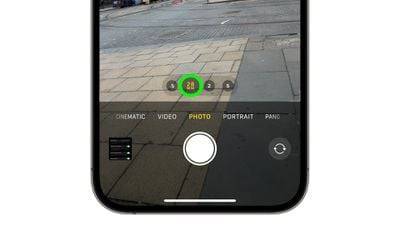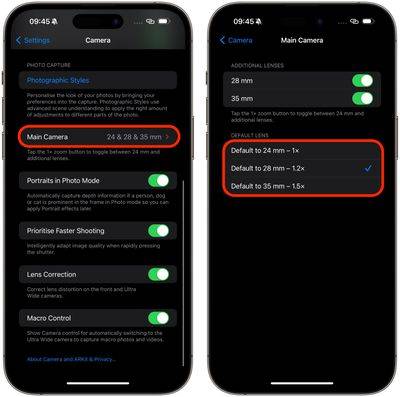iPhone 15 Pro camera focus adjustment guide
On Apple’s iPhone 15 Pro models, the main camera now allows users to switch between three focal lengths while shooting. Read on to learn how it works.

To take full advantage of the enhanced camera system on iPhone 15 Pro and iPhone 15 Pro Max, Apple has added three popular focal length options to the main camera’s optical zoom. There are default 24mm (equivalent to 1x optical zoom), 28mm (1.2x optical zoom), and 35mm (1.5x optical zoom).
Apple makes these specific focal lengths available to photography enthusiasts by using computational processing to crop the 48-megapixel images the new larger sensor can capture, so the result is always a high-resolution 24MP image.
You can manually switch between photo lengths by changing the optical zoom settings. The following steps demonstrate how it is done.
- Open the “Camera” app.
- Click the circled 1x icon above the shutter once to switch to the 28mm focal length (1.2x optical zoom.
- Click the circled 1x icon again 1x icon can switch to 35mm focal length (1.5x optical zoom).
- Click again to return to the default 1x focal length.

Only That's it. Keep in mind that due to technical reasons, these focus options are not available when shooting video and the camera will provide a zoom ring.
Change Default Focal Length
Apple has added an option to change the default Optical zoom settings, this can be very convenient if you are using a specific focal length. The following steps demonstrate how it is done.
- Open the Settings app.
- Scroll down and tap Camera.
- Tap Main Camera.
- Under Default Lens, select Default is 24mm – 1x, Default is 28mm – 1.2 and Default is 35mm – 1.5x.

This is what you want Done. The next time you shoot, you don’t need to set the focus before you start shooting – your preferred option is already selected.
The above is the detailed content of iPhone 15 Pro camera focus adjustment guide. For more information, please follow other related articles on the PHP Chinese website!

Hot AI Tools

Undresser.AI Undress
AI-powered app for creating realistic nude photos

AI Clothes Remover
Online AI tool for removing clothes from photos.

Undress AI Tool
Undress images for free

Clothoff.io
AI clothes remover

AI Hentai Generator
Generate AI Hentai for free.

Hot Article

Hot Tools

Notepad++7.3.1
Easy-to-use and free code editor

SublimeText3 Chinese version
Chinese version, very easy to use

Zend Studio 13.0.1
Powerful PHP integrated development environment

Dreamweaver CS6
Visual web development tools

SublimeText3 Mac version
God-level code editing software (SublimeText3)

Hot Topics
 High-quality large aperture portable ultra-wide-angle zoom Sony SEL1625G lens real shooting experience
Jul 17, 2024 am 12:46 AM
High-quality large aperture portable ultra-wide-angle zoom Sony SEL1625G lens real shooting experience
Jul 17, 2024 am 12:46 AM
At this year's CP+ exhibition in Japan, Sony released the FE24-50mmF2.8G lens, which is a lightweight and compact large-aperture G lens that can satisfy both static images and dynamic videos. In mid-April this year, Sony suddenly released the FE16-25mmF2.8G lens (hereinafter referred to as SEL1625G). It is a lightweight large-aperture zoom ultra-wide-angle lens with the same specifications as the SEL2450G. The Sony FE16-25mmF2.8G lens is an ultra-wide-angle zoom lens. It is not only suitable for shooting large scenes and landscapes, but it is also a lens suitable for video Vlog shooting. It is extremely portable when paired with the Sony A7 series or ZV-1 body. sex. Next, I will pass
 How to enable and disable camera focus presets on iPhone 15 Pro
Sep 23, 2023 pm 05:25 PM
How to enable and disable camera focus presets on iPhone 15 Pro
Sep 23, 2023 pm 05:25 PM
On Apple's iPhone 15 Pro models, users can switch between three preset camera focal lengths when shooting on the main camera. This article explains what they are and how to enable or disable them on your iPhone. To take full advantage of the enhanced camera system on iPhone 15 Pro and iPhone 15 Pro Max, Apple has added three popular focal length options to the main camera’s optical zoom. There are default 24mm (equivalent to 1x optical zoom), 28mm (1.2x optical zoom) and 35mm (1.5x optical zoom). Apple makes these specific focal lengths available to photography enthusiasts by using computational processing to convert the 48-megapixel images the new larger sensor can capture,
 iPhone 15 Pro camera focus adjustment guide
Sep 23, 2023 am 10:29 AM
iPhone 15 Pro camera focus adjustment guide
Sep 23, 2023 am 10:29 AM
On Apple's iPhone 15 Pro models, the main camera now allows users to switch between three focal lengths while shooting. Read on to learn how it works. To take full advantage of the enhanced camera system on iPhone 15 Pro and iPhone 15 Pro Max, Apple has added three popular focal length options to the main camera’s optical zoom. There are default 24mm (equivalent to 1x optical zoom), 28mm (1.2x optical zoom) and 35mm (1.5x optical zoom). Apple makes these specific focal lengths available to photography enthusiasts by using computational processing to crop the 48-megapixel images the new larger sensor can capture, so the result is always a high-resolution 24MP image. you
 Fully unleash the power of medium format Fujifilm GFX 100II Singapore Airshow shooting experience
Mar 05, 2024 am 09:00 AM
Fully unleash the power of medium format Fujifilm GFX 100II Singapore Airshow shooting experience
Mar 05, 2024 am 09:00 AM
On February 20, 2024, the new Singapore Airshow kicked off successfully at the Changi Convention and Exhibition Center in Singapore. The Singapore Airshow is one of the most well-known airshows in the world, ranking among the best in the world in terms of coverage, exhibitor strength and overall influence. Riding on the momentum of this Singapore Airshow, my country's domestically produced C919 civil trunk passenger aircraft, which has just been put into operation, also participated in overseas exhibitions for the first time, making its debut in front of the people of the world, demonstrating its charm and strength. This move has been described by many international media and institutions as the most prominent highlight of this air show and a milestone for Chinese manufacturing to go overseas. As an aviation enthusiast, I brought a Fuji medium format camera GFX100II to shoot and record this air show. Now I will share with you my shooting experience at this air show.
 What you need to know about iPhone 15 Pro Max 5x optical zoom
Sep 23, 2023 pm 12:01 PM
What you need to know about iPhone 15 Pro Max 5x optical zoom
Sep 23, 2023 pm 12:01 PM
Apple's iPhone 15 Pro Max uses a four-prism lens system that can achieve up to 5x optical zoom, which is an improvement over the 14x zoom of the iPhone 3 Pro and the previous generation iPhone 15. The telephoto lens on iPhone 15 Pro Max uses Apple’s most advanced camera anti-shake system to date, which combines optical anti-shake and autofocus 3D sensor offset modules. According to Apple, the iPhone 15 Pro Max’s telephoto lens opens at ƒ/2.8 for excellent light management when shooting with 5x enabled. In comparison, the Galaxy S23 Ultra's 10x lens has an ƒ/4.9 aperture. A lower aperture allows the camera's sensor to capture more
 Three cameras with 20x zoom, Honor selects Xiaopai Smart Camera Pro innovation is coming
Aug 23, 2024 pm 09:44 PM
Three cameras with 20x zoom, Honor selects Xiaopai Smart Camera Pro innovation is coming
Aug 23, 2024 pm 09:44 PM
Have you installed cameras in your home? In recent years, home camera products have suddenly become a hit. I asked my friends around me, and boy, every house has one, and some even have more than one. However, with the popularity of the product, it has also brought some complaints during use. For example, you can only see one place at the same time, and if you want to see other places, you have to adjust the pan/tilt and rotate the camera back and forth. There is a certain blind spot and time difference when viewing the picture; or when you want to take a closer look at a certain location in your home, you find that the picture is blurry and you cannot see it at all. Clarity; etc... The experience is greatly compromised. Honor Select and Xiaopai Technology jointly launched the Honor Select Xiaopai Smart Camera Pro featuring "three lenses and dual images". Provides new solutions to industry and user pain points
 vivo X100 Ultra design highlights revealed, will be equipped with a 200-megapixel telephoto lens for the first time
Apr 25, 2024 pm 06:55 PM
vivo X100 Ultra design highlights revealed, will be equipped with a 200-megapixel telephoto lens for the first time
Apr 25, 2024 pm 06:55 PM
Recently, a blogger exposed the design highlights and other information of the upcoming vivoX100Ultra new imaging flagship. vivoX100Ultra is expected to adopt a design language similar to vivoXFold3. The rear camera module adopts a ring layout and integrates the main camera, periscope telephoto lens and ultra-wide-angle lens. The iconic logo of Zeiss is printed on the camera module, which has A 200-megapixel telephoto lens with an equivalent focal length of 100mm improves the shooting experience again. vivoX100Ultra is expected to use the 50-megapixel Sony LYT900 main camera. The sensor has a 1-inch ultra-large bottom. Compared with the IMX989, its power consumption is reduced by 43%, while the dynamic range
 Tsinghua Optics AI appears in Nature! Physical neural network, backpropagation is no longer needed
Aug 10, 2024 pm 10:15 PM
Tsinghua Optics AI appears in Nature! Physical neural network, backpropagation is no longer needed
Aug 10, 2024 pm 10:15 PM
Using light to train neural networks, Tsinghua University results were recently published in Nature! What should I do if I cannot apply the backpropagation algorithm? They proposed a Fully Forward Mode (FFM) training method that directly performs the training process in the physical optical system, overcoming the limitations of traditional digital computer simulations. To put it simply, it used to be necessary to model the physical system in detail and then simulate these models on a computer to train the network. The FFM method eliminates the modeling process and allows the system to directly use experimental data for learning and optimization. This also means that training no longer needs to check each layer from back to front (backpropagation), but can directly update the parameters of the network from front to back. To use an analogy, like a puzzle, backpropagation





